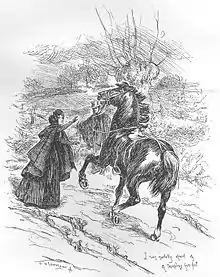Gytrash
The Gytrash /ɡaɪˈtræʃ/, a legendary black dog known in Northern England, was said to haunt lonely roads awaiting travelers.[1] Appearing in the shape of horses, mules, cranes or dogs, the Gytrash haunt solitary ways and lead people astray but they can also be benevolent, guiding lost travelers to the right road. They are usually feared.

In some parts of Lincolnshire and Yorkshire, the Gytrash was known as the Shagfoal and took the form of a spectral mule or donkey with eyes that glowed like burning coals. In this form, the beast was believed to be purely malevolent.
As this horse approached, and as I watched for it to appear through the dusk, I remembered certain of Bessie's tales, wherein figured a North-of-England spirit called a "Gytrash," which, in the form of horse, mule, or large dog, haunted solitary ways, and sometimes came upon belated travelers, as this horse was now coming upon me. It was very near, but not yet in sight; when, in addition to the tramp, tramp, I heard a rush under the hedge, and close down by the hazel stems glided a great dog, whose black and white colour made him a distinct object against the trees. It was exactly one form of Bessie's Gytrash -- a lion-like creature with long hair and a huge head [...], with strange pretercanine eyes [...]. The horse followed, -- a tall steed [...]. Nothing ever rode the Gytrash: it was always alone [...].
The Gytrash's emergence as Rochester's innocuous dog Pilot has been interpreted as a subtle mockery of the mysteriousness and romanticism that surrounds his character and which clouds Jane's perception.[3] Brontë's reference in 1847 is probably the earliest reference to the beast and forms the basis for subsequent citations.[4]
This spirit is also known as Guytrash and Guytresh according to The English Dialect Dictionary of Joseph Wright (1855–1930) where it is defined as a ghost that takes the form of an animal. These include a "great black dog" as well as "an evil cow whose appearance was formerly believed in as a sign of death." [5]
See also
- Barghest
- Black dog (ghost)
- Black Shuck
- Gwyllgi - A similar creature in Welsh folklore
- The Hound of the Baskervilles
References
- Brewer, E. Cobham (1894) [1870]. Brewer's Dictionary of Phrase and Fable (New and Enlarged ed.).
- Brontë, Charlotte (1847) [1847]. "Chapter XII". Jane Eyre. London, England: Smith, Elder & Co. Retrieved 2008-11-15.
- Dr. Sally Minogue (1999). "Introduction". Jane Eyre. p. xv. ISBN 978-1-85326-020-9.
- Wood, Dr. Juliette. "Gytrash" (PDF): 2. Retrieved 2009-01-13. Cite journal requires
|journal=(help) - Wright, Joseph (1923). The English Dialect Dictionary (Vol. 2). Humphrey Milford, Oxford University Press. p. 770.
